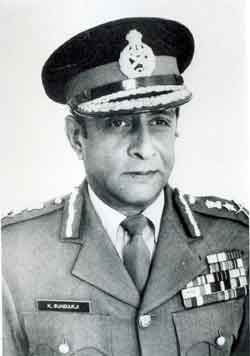The Expanding Domains of War
May 09, 2019 By Kanchana Ramanujam
Introduction
Technological and sociological changes have brought about a paradigm-shift in the understanding of war, battle-field, and indeed, victory and defeat. Warfare has metamorphosed from the classic military aggression only, to include a number of other domains such as political, legal, diplomatic, etc. This has led to a corresponding change in the weapons used - currency, water, markets, narratives, malware, etc. are the new weapons.
The objective of warfare is changing from imposing a military defeat to rendering the military might of the adversary meaningless, exemplified by the use of lawfare, cabbage tactics, Little Green Men, Little Blue Men, unmanned systems, creation of artificial islands, etc. Former United States Secretary of Defense, James N Mattis, called such actions ‘competition’ (distinguishing it from armed ‘conflict’) in US’ National Defense Strategy released in January 2018.1 The word ‘competition’ initially figured in the 2017 Multi-Domain Battle paper of the US Army.2
There is less emphasis on bloodshed and increasingly more emphasis on incapacitating the adversary, the key to which is capabilities in the domains of cyber, space, and the electromagnetic spectrum. The 7th generation warfare is indeed about paralysing a country by targeting their network-based critical assets - banking, electricity, nuclear facilities, etc.
Domain-Specific Vulnerabilities - The Assassin’s Mace
Targeting the adversary’s domain-specific weakness gives the weaker side the change to dominate in a conflict, and the stronger side to prevail without inviting international intervention.
Hezbollah
Hezbollah, a non-state actor, which used the tactics of suicide bombing and frontal attacks against Israel in the 1990s, could challenge the might of the Israeli Defence Forces in the 2006 Lebanon War when it prosecuted electronic warfare, exploiting the complex communication network it built stretching across Beirut to the Israel-Lebanon border. It simultaneously prosecuted psychological warfare, systematically using al-Manar Television channel. These were in addition to dexterously utilising guerrilla as well as conventional capabilities.
Russia
Russia has mastered the art of what it calls non-linear warfare. Be it shaping the environment by bringing up the issue of Russian identity (psychological operations), leveraging Gazprom as a tool for coercion, economic carrot and stick approach, use of irregular forces, cyber aggression, etc.
China
China’s unrestricted warfare is based on exploitation of economy, law, networks, etc. rather than a direct military confrontation. The same is evident in China’s impressive space and cyber capabilities, exploitation of audio and visual means of mass communication for narrative building, debt diplomacy, use of deceptive, irregular forces (maritime militia), etc.
Integrated, Multi-Dimensional Response for Multi-Dimensional Threats
In response to the Russian and Chinese anti-access/area denial (A2/AD) capabilities, the US established the I2CEWS (Intelligence, Information Operations, Cyber and Electronic Warfare, and Space and Signal) unit.3
Led by an officer of the rank of Lieutenant Colonel, the I2CEWS is a battalion-sized force. It has, as the name suggests, the following four companies :
1.Intelligence
This company would provide a picture of the operating environment for kinetic and non-kinetic actions.
2.Information Operations
This company would provide information support to combat troops. Information operations, including propaganda, would now be a part of combat.
3.Cyber and Electronic Warfare
This company is dedicated to attacking the wireless, tactical networks by hacking/jamming.
4. Space and Signal
This company would collect intelligence data from signals intelligence and/or reconnaissance satellites.
A second battalion of the I2CEWS will come up in the US European Command.
The Indian Scenario
India has already taken the initial steps towards tackling threats in the unconventional domain. During the Combined Commanders’ Conference held in Jodhpur last year, the Prime Minister approved cyber, special forces, and space divisions for the Armed Forces.4 Recently, the Indian Armed Forces conducted Cyberex, a two-day, joint cyber exercise, along with other stakeholders such as the the Indian Computer Emergency Response Team, the National Technical Research Organisation, etc.5
As the battlefield evolves in terms of actors, dimensions, space, and time, India needs to be prepared to act simultaneously and synergistically in every dimension of conflict - be it land, air, sea, space, cyber, as well as electromagnetic spectrum. She also needs to arm herself to seize the first mover’s advantage in these domains.
For a dedicated and integrated, multi-domain structure, the following points require consideration:
1.Agnosticism/Compatibility
For seamless functioning across various platforms, hardware/software agnosticism (compatibility) would be essential.
2.C4 system
A robust, secure, and rapid communication network is another essential requirement. Command, Control, Communications, Computers.
3.Jointness
Multi-domain units/operations would require true jointness. This may also include weapon-systems and capabilities for cross-domain use.
Such a structure should be able to function independently as also seamlessly with the tri-services.
4. Personnel Base
Would the personnel for such a structure comprise of specialists from within the tri-services or will separate recruitment for the same be done.
5. Budgetary allocation
Such a structure would require specific allocation of budget. There cannot be any uncertainty over the amount earmarked.
6. Increasing Awareness at all Levels
Such a structure would be completely new. Proper orientation of the leadership as well as rank and file could be looked at.
7.Nodal agency
Such a structure would require a nodal agency for complete control and functioning. The Integrated Defence Staff may be that agency.
Conclusion
The proliferation of different tools of warfare and resultant expansion of the battle-field means that no particular service can guarantee victory. The modern battlefield needs not just military but political, psychological, electronic, technological warriors too. To win today’s ‘wars’, one needs a whole-of-government (WOG) approach with elements of Comprehensive National Power as part of the action/response system.
The Armed Forces should be prepared to take threats in all domains, as also take offensive actions in those domains. A synergistic, multi-domain, WOG approach may prove to be the decisive factor in battle-field dominance.

